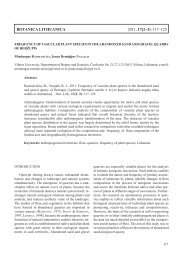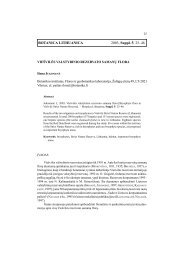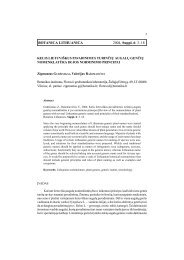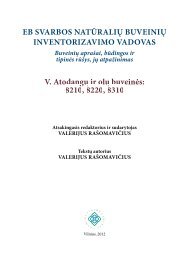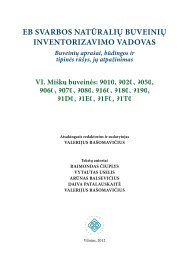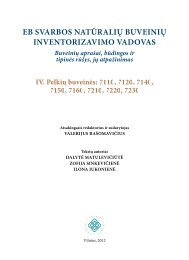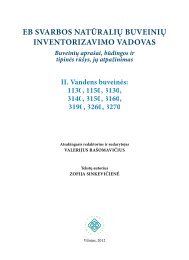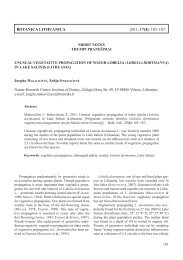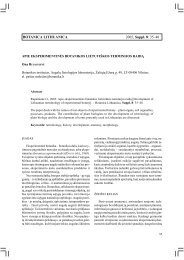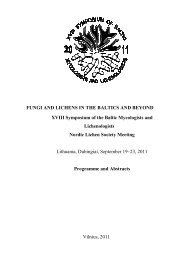BOTANICA LITHUANICA 2011, 17(2–3): 135–136
BOTANICA LITHUANICA 2011, 17(2–3): 135–136
BOTANICA LITHUANICA 2011, 17(2–3): 135–136
Create successful ePaper yourself
Turn your PDF publications into a flip-book with our unique Google optimized e-Paper software.
Botanica Lithuanica <strong>2011</strong>, <strong>17</strong>(<strong>2–3</strong>): <strong>135–136</strong><br />
CHRONICLE<br />
18th symposium of the baltic mycologists and lichenologists<br />
19–23 September <strong>2011</strong>, Dubingiai, Lithuania<br />
A traditional Symposium of the Baltic Mycologists<br />
and Lichenologists was organized by the Nature<br />
Research Centre, Department of Botany and Genetics<br />
of Vilnius University and Lithuanian Mycological<br />
Society. The event took place in a serene corner of<br />
Asveja Regional Park, on the shore of Lake Asveja.<br />
The participants were not only from the Baltic States:<br />
60 mycologists and lichenologists came from Belarus,<br />
Bulgaria, Canada, Estonia, Finland, Germany, Hungary,<br />
Latvia, Lithuania, Poland, Russia and Sweden.<br />
Lichenologists especially actively attended the 18th<br />
Symposium, because for the first time it was held<br />
together with the Nordic Lichen Society meeting.<br />
Scientific program of the Symposium covered<br />
various subjects and held a number of interesting and<br />
noteworthy presentations. Oral presentations were<br />
divided into two sections: Lichenology and Mycology.<br />
Taxonomical problems were discussed in the following<br />
reports: Phylogenetic studies of three pendent<br />
Usnea species (F. Högnabba, H. Rämä, P. Halonen,<br />
H. Lindgren, S. Velmala, S. Stenroos and L. Myllys,<br />
Finland); Spore ornamentation and apothecia surface in<br />
the lichen families Gyalectaceae and Coenogoniaceae<br />
(L. Gagarina, Russia); The lichen genus Ochrolechia<br />
in Europe (M. Kukwa, Poland); Erysiphales – new<br />
tendencies of systematics (B. Bankina and G. Bimsteine,<br />
Latvia). A number of reports dealt with ecology and<br />
conservation of lichens and fungi: Diversity of rare<br />
Participants of the18th Symposium of Baltic Mycologists and Lichenologists<br />
135
wood-inhabiting fungi in East European temperate<br />
old-growth forests (Ž. Preikša, Lithuania); Further<br />
results on conservation of lichenized fungi in Hungary<br />
(E. Farkas, L. Lőkös and K. Molnár, Hungary); Lichens<br />
in a chronosequence of 16–236 year-old kelo trees<br />
(P. Lõhmus, A. Lõhmus and J. Kouki, Estonia); Lichens<br />
as indicators of old-growth and pristine forests in<br />
Russian Far East (E. S. Kuznetsova, D. E. Himelbrant<br />
and I. S. Stepanchikova, Russia); Role of the<br />
Fennoscandian green belt in conservation of the lichen<br />
biota in eastern Fennoscandia (M. A. Fadeeva and<br />
A. V. Kravchenko, Russia); Lichens of calcareous rocks<br />
in Finland (J. Pykälä, Finland); Post-fire recovery of<br />
the lichen cover in West Siberian forest: zonal aspects<br />
(S. Abdulmanova, Russia); On the lichens of Svalbard<br />
archipelago (L. Konoreva, Russia). In Mycological<br />
section, a particularly large number of presentations<br />
dealt with problems of plant pathology: Do endophytic<br />
fungi of timothy have potential for bioprospecting?<br />
(T. Varvas and K. Kasekamp, Estonia); Conifer bark<br />
against pine needle cast? Data about conifer bark extract<br />
impact on Lophodermium seditiosum mycelium growth<br />
in vitro (R. D. Ķiesnere, D. Kļaviņa, N. Arhipova,<br />
T. Gaitnieks, O. Polis, A. Korica and M. Daugavietis,<br />
Latvia); Fungi associated with seed and plant infection<br />
of pepper (R. Rodeva, Z. Stoyanova, E. Survilienė and<br />
P. Chavdarov, Bulgaria and Lithuania); Pathogenic<br />
mycobiota on plants of the genus Alnus Mill. (M. A. Tomoshevich<br />
and E. V. Banaev, Russia). One presentation<br />
was interdisciplinary: Mycotoxins in reindeer lichens<br />
(G. Kononenko, Russia). The poster session was also<br />
divided into Mycological and Lichenological sections,<br />
in which 28 posters covering a variety of subjects were<br />
discussed.<br />
Also traditionally, a significant part of the Symposium<br />
time was devoted to field studies. Three field<br />
trips within the territory of Asveja Regional Park<br />
were organized: to the valley of the Žverna Rivulet,<br />
to Blužnėnai forest and to the valley of Jurkiškis<br />
and Stirnelė Rivulet. Mycologists and lichenologists<br />
collected a great variety of interesting fungi and lichen<br />
species, noted new, hitherto unknown localities of rare<br />
and protected species. The results of these collections<br />
will be made available as publications in scientific<br />
journals, the data on new localities of the Lithuanian<br />
Red Data Book species will be made available to the<br />
Directorate of Asveja Regional Park.<br />
Home going of the Symposium participants was<br />
crowned by an excursion to Asveja Regional Park<br />
and Aukštaitija National Park as well as visits to the<br />
museums of Ethnocosmology and Apiculture.<br />
Next Symposium of the Baltic Mycologists and<br />
Lichenologists will take place in Latvia in 2014.<br />
Jurga Motiejūnaitė<br />
Nature Research Centre, Institute of Botany,<br />
Žaliųjų Ežerų Str. 49, LT-08406 Vilnius, Lithuania<br />
136



